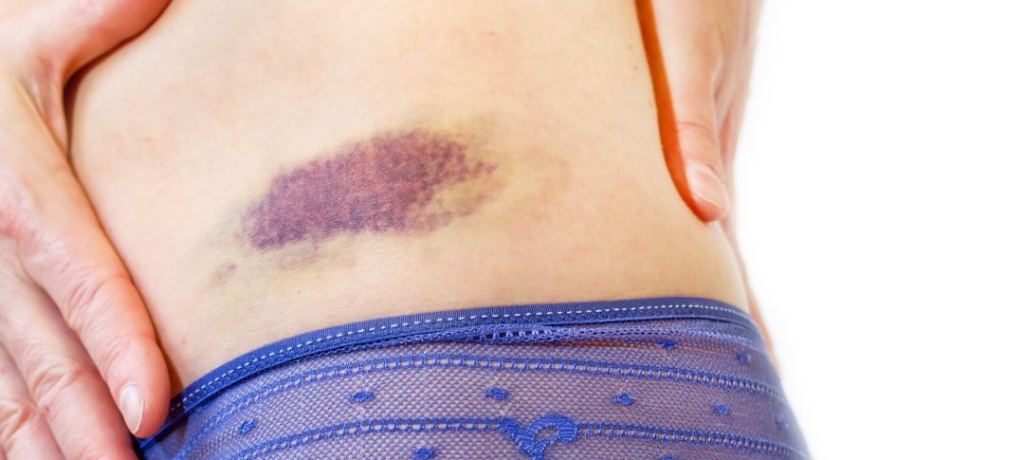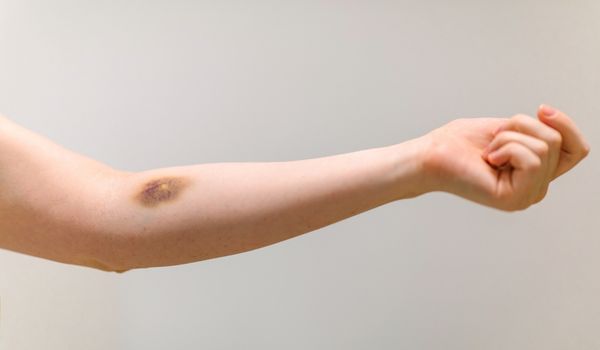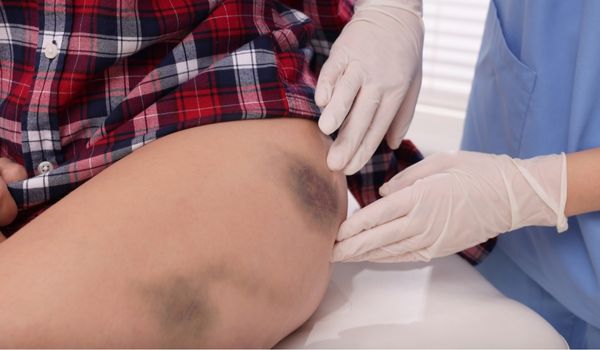
Everything You Need To Know about Haematomas
A haematoma is a collection of blood beneath the skin that looks like a bulging bruise and commonly occurs after plastic surgery. You can develop a haematoma within 48 hours following your procedure, or the blood can pool up over 7-10 days after your surgery and after the drains are removed.
Most post-op haematomas after plastic surgery resolve on their own. However, persistent haematoma lumps can become infected and may require antibiotic treatment and surgical drainage.
Learn more about haematoma after cosmetic surgery, how they develop, how to manage them, and tips on how to lower your risk of having them.
What Is a Haematoma?
A haematoma is a pocket of blood that collects under the skin, outside the blood vessels – it’s a common complication of plastic surgery and usually develops near the incision site.
Following an injury to a blood vessel under your skin, blood begins to leak into the surrounding tissue. As your blood clots, a haematoma forms.
It usually takes 48 hours for a postoperative haematoma to develop, but sometimes it can take up to 10 days after the surgical drains have been removed.
What Causes a Haematoma After Plastic Surgery?
A subcutaneous haematoma is caused by an injury to the blood vessels under your skin.
Most plastic surgeries involve incisions into the skin and tissue, detaching and reattaching the skin, and removing tissue from the body. All these steps could injure the blood vessels beneath your skin. That’s a normal part of surgery and cannot be avoided.
When the wall of a blood vessel is damaged during plastic surgery, blood leaks into the surrounding tissue and starts pooling. If the blood isn’t drained, it starts to clot, and a haematoma forms after surgery.
Haematoma Risk Factors
Anyone can develop a haematoma after an injury or a cosmetic procedure. Nonetheless, you’re more likely to get a post-surgical haematoma in case:
- You take blood-thinning medications that increase the risk of bleeding (e.g: Aspirin, ibuprofen, warfarin, clopidogrel, apixaban, rivaroxaban, herbal supplements)
- You have a bleeding disorder (also called coagulopathy) – which is usually a genetic disorder that increases your bleeding tendency
- You usually bleed easily and profusely after minor injuries
- You have a viral infection ((HIV, hepatitis C, parvovirus)
- You have aplastic anaemia (your body doesn’t produce enough red blood cells)
- You have a low blood platelet count (thrombocytopenia)
- You have alcohol consumption problems (alcohol thins the blood)
- You have a vitamin D deficiency
If you have one or more of the mentioned factors, you’ll have a higher risk of bleeding and forming haematomas after plastic surgery.
What Are The Symptoms Of Haematoma?
A haematoma may cause the following symptoms in the affected area:
- Discolouration similar to severe bruising (from the collection of blood)
- Uneven or sudden swelling or bulging under the wound
- Tenderness and warmth in the skin surrounding the haematoma
- Pain
Usually, the more severe the blood vessel injury, the worse the symptoms. The extent of the swelling and discoloration can indicate the severity of the haematoma.
What Are the Complications of Haematoma?
An untreated haematoma can cause some common complications, such as:
- An infection: a haematoma has no blood supply- it’s a collection of old blood. Therefore, if a haematoma remains for a long time, it can become infected by bacteria or other microbes and cause a high fever, redness, and pain
- Delayed wound healing: if the sac of blood becomes big enough, it can compress the surrounding tissues and cut their oxygen supply which is needed for healing and recovery. It can also create pressure and stress over the incision. Consequently, a large haematoma can cause surgical incision separation, scarring abnormalities, and delayed healing from surgery
What Plastic Surgeries Can Cause Haematoma?
Haematoma at the incision site is a risk in nearly all surgeries, including plastic surgery. The most common types of cosmetic surgeries that can result in haematomas are:
- Facelift (a haematoma is the most common complication after a facelift procedure)
- Breast augmentation surgery (1 % of patients develop a haematoma after getting implants)
- Tummy tuck
- Butt lifts
- Thigh lift
- Arm lift
How Is a Haematoma Treated After Plastic Surgery?
Haematoma treatment depends on the severity of the blood build-up.
Most small post-op haematomas resolve by themselves, the blood usually gets reabsorbed by the body.
If the haematoma doesn’t go away after a long time after your plastic procedure, it may require surgical drainage.
Natural ways to treat a haematoma after surgery
Often, a haematoma doesn’t require medical treatment – the body absorbs the accumulated blood, and the haematoma begins to shrink. The sac of blood eventually dissolves.
It can take months for the haematoma to resolve completely after a cosmetic procedure. However, some steps can help you manage a postoperative haematoma at home and help the blood reabsorb faster:
- Apply a cold compress or ice pack: apply an ice pack or a cold compress for 10 to 20 minutes to the area affected by the haematoma. The cold temperature can help reduce swelling after plastic surgery. Repeat this at least three times a day
- Apply a heating pad or a warm compress: the heat can improve blood flow and helps the haematoma become reabsorbed. Apply heat pads for around 10 minutes at a time, three times a day, to help drain your haematoma after a plastic surgery
- Rest and protect the area affected by haematoma: avoid massaging, bumping, or compressing the bruised area after cosmetic surgery
- Wrap the affected area with an elastic bandage: the pressure from an elastic bandage, such as an Ace wrap, can help decrease swelling and improve blood drainage. Be careful not to wrap too tightly – too much pressure can restrict the blood flow and increase the swelling in the haematoma
- Elevate the affected area: if you have a bruise-like mark on your arm or leg following an arm lift or a thigh lift, try to elevate your arm or foot higher than your heart
- Pain medication: pain meds, such as acetaminophen (Tylenol), can help reduce symptoms of pain caused by a haematoma
However, if you’re treating your haematoma at home, avoid taking other over-the-counter (OTC) meds such as Aspirin or ibuprofen (Advil, Motrin). These OTC meds can slow down blood clotting and worsen your haematoma.
Medical treatment of haematoma after plastic surgery
More severe haematomas that continue to grow may require medical intervention to drain the pooled blood:
- Needle aspiration: using a needle and a syringe, the healthcare provider can remove the build-up of blood by a process called aspiration. Nevertheless, this haematoma drainage method isn’t recommended anymore because the haematoma often refills afterward and requires additional management
- Incision and drainage: the blood in a persistent haematoma is drained by reopening the incision from the cosmetic surgery. A clean incision is made, then the haematoma is evacuated
- Liposuction: less frequently, liposuction is used to evacuate a haematoma. First, the lump of blood is injected with an anaesthetic (such as xylocaine). Next, a small incision is made in the area affected by the haematoma. Then, a thin tube (cannula) is inserted through the incision to suck out the blood clots and clear the haematoma. Finally, the incision is closed
- Antibiotics: if a haematoma becomes infected, it becomes full of pus and causes a high fever and pain. Infected haematomas require antibiotic treatment in addition to drainage to relieve the symptoms of infection
Ways To Prevent Haematoma
There are several steps that you can do before your plastic surgery that can help prevent a haematoma from forming:
- Avoid drinking alcohol before surgery: alcohol acts as a blood thinner and increases your risk of bleeding. Avoiding alcohol consumption in the days leading up to your cosmetic procedure can help you avoid haematoma after surgery
- Stop taking all blood thinning medication before surgery: Over-the-counter meds such as vitamin E, herbal supplements (Gingko, ginseng, St. John’s Wort), anti-inflammatory drugs (Advil), and Aspirin (ibuprofen, Aleve, Motrin) can increase bleeding and bruising after surgery. Stopping all OTC drugs before surgery can reduce your risk of haematoma formation
- Resolve medical conditions before surgery: diagnosing and treating a medical condition such as anaemia, a viral infection, or iron deficiency can help you prevent a post-surgical haematoma
Additionally, there are things you can do after your plastic surgery to reduce your chances of developing a haematoma:
- Surgical drains: drains are used near incision sites after surgery to prevent excessive fluid build-up after abdominoplasty or breast surgery. They can reduce swelling and prevent several post-op complications
- Wear compression garments: wear your compression garments and elastic straps as recommended by your surgeon after your cosmetic procedure. These can help reduce swelling and help your wounds heal faster
- Avoid excessive heat: although mild heat can help improve blood flow and drainage, excessive heat can increase the chances of a haematoma after plastic surgery. Avoid exposing your wounds to too much heat from the sun, hot tub, heating pads, etc.
- Take it easy: during your recovery, avoid vigorous exercises and strenuous physical activity as they can raise your blood pressure. High blood pressure increases inflammation and swelling and puts you at a higher risk for developing a haematoma after cosmetic surgery. To avoid any post-op complications, take it easy for a while
- Rest if you get nauseous: a lot of patients experience postoperative nausea especially while the anaesthesia is getting flushed out of their system. Vomiting can increase the risk of haematoma after cosmetic procedures. Thus, if you experience nausea after your surgery, try to rest until your nausea passes to prevent haematoma after your plastic surgery
Is Hematoma a Dangerous Complication?
Even though haematomas are not usually dangerous, they can be painful, uncomfortable, and aesthetically unpleasing.
Nevertheless, if a haematoma becomes large and remains untreated for a long time after plastic surgery, it can cause some health concerns. The dangers of an untreated postoperative haematoma include infection, poor wound healing, and abnormal scarring.
If you develop a bruise-like mark near your incisions after plastic surgery, your surgeon can provide you with information on how you can reduce a haematoma. Seek medical care if the blood pocket starts growing in size, showing signs of infection, or if the skin around it becomes too tight.
Medical References about Haematoma after Plastic Surgery
- Hematomas in Aesthetic Surgery
- How to Prevent and Treat Complications in Facelift Surgery, Part 1: Short-Term Complications – PMC
- Reminder of important clinical lesson: Traumatic subcutaneous haematoma causing skin necrosis – PMC
Further Reading Related to Complications after Plastic Surgery
- Best Compression Garments for Plastic Surgery Patients by Dr Carmen Munteanu
- Plastic Surgery Risks and Complications by Dr. Guy Watts
- Risks and Complications of Surgery by Dr Bish Soliman
- Potential Risks and Complications of Plastic Surgery – Dr Michael Kernohan
- Smoking and Plastic Surgery | Dr Jake Lim FRACS (Plast)
- Risks of Surgery – London Plastic Surgeons




